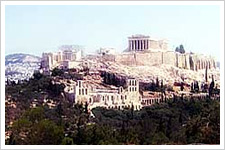 Hi, I’m Rudy Maxa...traveling to the birthplace of democracy, the land where classical theatre took root, and where great philosophers posed eternal questions. Next up, it’s Athens, on Smart Travels.
Hi, I’m Rudy Maxa...traveling to the birthplace of democracy, the land where classical theatre took root, and where great philosophers posed eternal questions. Next up, it’s Athens, on Smart Travels.
Bleached stone pillars against a blue Mediterranean sky...marble pathways trod by mythical deities...rocky hillsides decked in garlands of olive trees...This is Greece. Land of the gods. Zeus, Apollo, Athena, Poseidon...Where early thespians strutted in concentric theaters...where pilgrims journeyed for miles to seek guidance from ancient oracles...and where today tourists travel from around the world to clamber over ruins weathering in the hot Greek sun.
TIP
A classic reference on Greek mythology: "The Greek Myths" by Robert Graves. You'll find the review at www.largeprintreviews.com.
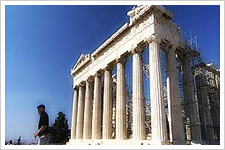 To travel in Greece is to embark on an odyssey, a great quest for enlightenment. It’s a chance to walk where historic thinkers like Socrates, Plato and Aristotle walked. To climb sacred pathways to ancient temples, listen to their stories and imagine the glory of it all.
To travel in Greece is to embark on an odyssey, a great quest for enlightenment. It’s a chance to walk where historic thinkers like Socrates, Plato and Aristotle walked. To climb sacred pathways to ancient temples, listen to their stories and imagine the glory of it all.
On this trip, we’ll take in Athens marvels, and work in a couple of easy trips outside the city. We’ll make a pilgrimage to the oracle of Delphi, stop off at a medieval monastery and relax at Greece’s most beautiful port, Naufplion.
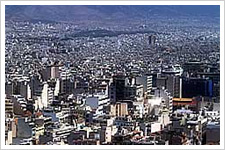 Athens was named for Athena, the goddess of wisdom. Most foreigners think of Athens as an ancient metropolis, but apart from the ruins, the vast majority of the city developed quickly over the last century. When Athens became the country’s capital in 1834, it was a modest town of 6000 residents. Today the population tops three and a half million and growing, as Greeks from rural areas move here in search of work. The unfortunate result is a brown shroud of pollution that seems to perpetually hang over the city, though recently the problem has lessened thanks to improvements in mass transit and heating systems.
Athens was named for Athena, the goddess of wisdom. Most foreigners think of Athens as an ancient metropolis, but apart from the ruins, the vast majority of the city developed quickly over the last century. When Athens became the country’s capital in 1834, it was a modest town of 6000 residents. Today the population tops three and a half million and growing, as Greeks from rural areas move here in search of work. The unfortunate result is a brown shroud of pollution that seems to perpetually hang over the city, though recently the problem has lessened thanks to improvements in mass transit and heating systems.
Most tourists regard Athens as an obligatory stop - see the famous sites then leave as quickly as possible. But this is a special place. A place with history so immediate, so accessible, it calls to be savored and reveled in.
We’re starting with the biggest and best - an icon that’s come to symbolize the advent of western civilization.
 The Acropolis was the heart of ancient Athens. This simple rock fortress holds the world’s most spectacular concentration of antiquity. Standing here gives those dusty textbooks you read in school an exhilarating new dimension. Religious and civic life in the old city revolved around this sacred citadel. And it was the center of a cultural explosion in which Athens would influence the western world more than any city on earth.
The Acropolis was the heart of ancient Athens. This simple rock fortress holds the world’s most spectacular concentration of antiquity. Standing here gives those dusty textbooks you read in school an exhilarating new dimension. Religious and civic life in the old city revolved around this sacred citadel. And it was the center of a cultural explosion in which Athens would influence the western world more than any city on earth.
The Golden Age of Athens lasted only about fifty years from 480 to 430 BC, but during this time, the Greeks made huge leaps in philosophy, politics, science and the arts. Architecture flourished, and the Athenian statesman, Pericles, initiated a grand building program that would transform the Acropolis.
Temples were the most important structures of their day. Made of marble or stone, they were built with a long main room surrounded by columns. Greek temples were so beautiful that, more than a two thousand years later, European and American architects continue to copy them.
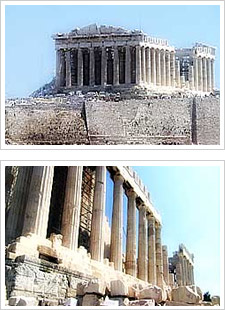 The 2400-year-old Parthenon was intended as a new sanctuary for Athena. The shrewd builders knew that straight lines, when viewed from below, appear curved. So they compensated. The columns were designed to become slightly broader half way up their height, and the pavement that the temple sits on rises in a bulge along the length. As a result, the lines of the Parthenon create an illusion of symmetry and balance.
The 2400-year-old Parthenon was intended as a new sanctuary for Athena. The shrewd builders knew that straight lines, when viewed from below, appear curved. So they compensated. The columns were designed to become slightly broader half way up their height, and the pavement that the temple sits on rises in a bulge along the length. As a result, the lines of the Parthenon create an illusion of symmetry and balance.
The temple was famous throughout the ancient world, but even Pericles couldn’t have imagined that after two millenia it would still draw more than three million visitors a year.
TIP
To avoid huge crowds and hot mid-day sun, visit the Acropolis early in the morning. For more on the Acropolis and surrounding area, check out the
A Quick Tour of the Acropolis and A Quick Tour of the Agora.
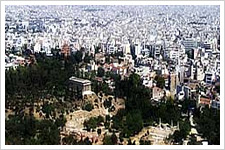 Spreading out below the acropolis, the Agora (or marketplace) was the center of everyday activity. Here, Socrates was tried before the courts, and in the nearby theatre, Aristophanes and Euripides staged their dramatic masterpieces.
Spreading out below the acropolis, the Agora (or marketplace) was the center of everyday activity. Here, Socrates was tried before the courts, and in the nearby theatre, Aristophanes and Euripides staged their dramatic masterpieces.
Government buildings, schools and market stalls supported a thriving commercial hub. Farmers sold fresh produce here, and craftsmen peddled their hand-hewn works. Politicians met to conduct government business while philosophers debated. Like the other Greek city-states, Athens was actually a small country, with its own economy, government and religion.
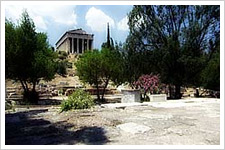 Ancient Greece is famous for being the cradle of democracy, but it only remotely resembled today’s democratic governments. While it’s true that every citizen participated in government, there was a catch: not everyone could be a citizen. Women, slaves and men whose fathers weren’t born in Athens were out of luck.
Ancient Greece is famous for being the cradle of democracy, but it only remotely resembled today’s democratic governments. While it’s true that every citizen participated in government, there was a catch: not everyone could be a citizen. Women, slaves and men whose fathers weren’t born in Athens were out of luck.
Slavery was common here. In fact, everyone who wasn’t poor owned at least one slave, and wealthy men sometimes owned twenty or more. Yet, despite such inhumane practices, this society still sowed the seeds of a democratic form of government.
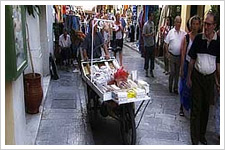 The part of the old city that’s still inhabited to this day is called the Plaka. Tucked along the lower northern slopes of the Acropolis, this was the whole of Athens a century and a half ago. It’s a symbolic link between ancient Athens and today’s modern sprawl. Cars are prohibited from all but a few main streets, and the twisting cobblestone roads are a delight to wander. It’s always busy and generally safe. The diverse restaurants, bars, and souvenir shops commingle with remains of ancient Greek and Roman ruins.
The part of the old city that’s still inhabited to this day is called the Plaka. Tucked along the lower northern slopes of the Acropolis, this was the whole of Athens a century and a half ago. It’s a symbolic link between ancient Athens and today’s modern sprawl. Cars are prohibited from all but a few main streets, and the twisting cobblestone roads are a delight to wander. It’s always busy and generally safe. The diverse restaurants, bars, and souvenir shops commingle with remains of ancient Greek and Roman ruins.
With plenty of inexpensive hotels, most visitors find the Plaka a good neighborhood to stay in.
 We opted to stay outside the old city in one Athens’ most comfortable boutique hotels, the Andromeda. It’s not the least expensive option, but if you’re with a family or group, the Andromeda Apartments can be a good value.
We opted to stay outside the old city in one Athens’ most comfortable boutique hotels, the Andromeda. It’s not the least expensive option, but if you’re with a family or group, the Andromeda Apartments can be a good value.
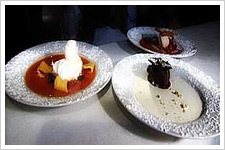 Preparing simple yet delicious food using fresh, raw ingredients has always been a Greek specialty. The ancients considered cooking both a science and an art. During Roman rule, the upper class Romans sent their children to study cooking in Athens. We’re checking out the modern expression of Greek cooking at the hot new Aristeria Dexia restaurant. They offer traditional recipes with a contemporary twist, and a dizzying selection of wines from their wine cellar.
Preparing simple yet delicious food using fresh, raw ingredients has always been a Greek specialty. The ancients considered cooking both a science and an art. During Roman rule, the upper class Romans sent their children to study cooking in Athens. We’re checking out the modern expression of Greek cooking at the hot new Aristeria Dexia restaurant. They offer traditional recipes with a contemporary twist, and a dizzying selection of wines from their wine cellar.
TIP
Not sure where you'd like to eat? chck out this article on www.usatoday.com.
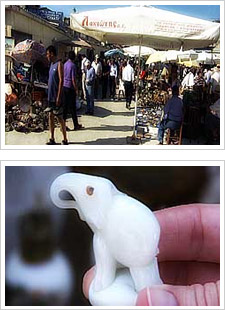 On Sunday mornings the place to be is the flea market on Monastiraki square. The market is a vast open-air bazaar catering to the needs of local Athenians. There’s everything from cookware …to clocks, …from glass elephants...to evil eyes.
On Sunday mornings the place to be is the flea market on Monastiraki square. The market is a vast open-air bazaar catering to the needs of local Athenians. There’s everything from cookware …to clocks, …from glass elephants...to evil eyes.
As you wander the flea market, you’ll discover that Athens is the unrivaled king of mass-produced kitsch. You’re bound to come away with your own “special” souvenir.
The market is also a great place for people watching. You may catch sight of a shopkeeper handling worry beads… or perhaps overhear a heated debate. The Greeks are nothing if not lively. And above all else, they have a robust appetite for enjoying what life has to offer.
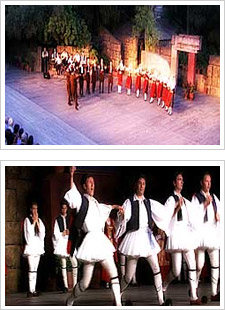 Greeks love music and dance. And the very best place to see authentic Greek dances is in the open-air Dora Stratou Theatre on Philopappou Hill. Dora Stratou, the daughter of a former Prime Minister, founded this dance troupe forty years ago to help preserve the country’s dance heritage, which has been handed down from generation to generation since antiquity. Stratou spent years painstakingly collecting traditional costumes from all across Greece. Today these genuine costumes are true treasures because the craftsmen and fabrics no longer exist. The company has dancers from different parts of the country, such as Crete or Pontos, who work at perfecting the steps unique to their region.
Greeks love music and dance. And the very best place to see authentic Greek dances is in the open-air Dora Stratou Theatre on Philopappou Hill. Dora Stratou, the daughter of a former Prime Minister, founded this dance troupe forty years ago to help preserve the country’s dance heritage, which has been handed down from generation to generation since antiquity. Stratou spent years painstakingly collecting traditional costumes from all across Greece. Today these genuine costumes are true treasures because the craftsmen and fabrics no longer exist. The company has dancers from different parts of the country, such as Crete or Pontos, who work at perfecting the steps unique to their region.
TIP
Want to check out a performance? Go to www.grdance.org.
National Archaeological Museum ![]()
 When in Athens, the National Archaeological Museum should be near the top of your must-see list. This fascinating collection of prehistoric and classical Greek art is one of the world’s great museum experiences.
When in Athens, the National Archaeological Museum should be near the top of your must-see list. This fascinating collection of prehistoric and classical Greek art is one of the world’s great museum experiences.
It displays ancient masterpieces in sequence from the Neolithic age to the last years of the Roman empire.
To look at everything in detail would take days, but we’ll check out a few of the highlights.
The Hall of Mycenaean Antiquites boasts a dazzling array of gold placed in the royal tombs of Mycenae some 3500 years ago. The Mycenaens, who were centered on Greece’s Peloponnesian peninsula, inspired many of the myths and legends that were embraced during the Golden Age. This mask was first believed to be death mask of the great King Agamemnon, though historians later discovered it was several centuries older.
 The beauty and sheer number of sculptures is astounding. Sculpture was one of the most sophisticated forms of Greek art, and the museum is an ideal place to follow the stylistic evolution over the centuries. Back around the 6th century BC, it was popular to represent young men in this stylized way, with stiff body posture and enigmatic smiles.
The beauty and sheer number of sculptures is astounding. Sculpture was one of the most sophisticated forms of Greek art, and the museum is an ideal place to follow the stylistic evolution over the centuries. Back around the 6th century BC, it was popular to represent young men in this stylized way, with stiff body posture and enigmatic smiles.
In contrast, this more naturalistic Poseidon, carved a hundred years later, shows the god’s strength and power as he stands poised to hurl his trident.
The Horse with the Little Jockey is an unusually animated sculpture, the jockey anxiously urging his mount forward.
This bronze figure, most likely that of a boxer, is especially intriguing. His life-like eyes have an almost hypnotic quality.
Discovered on the island of Delos, this statue shows an amorous Pan making advances toward an irritated Aphrodite while she gets ready to smack him with a shoe. Unfortunately, many Greek bronzes were lost over the centuries when the metal was melted down to make weapons of war.
 Greece certainly has had more than its share of warfare, from the ancient rivalry between Athens and Sparta to the modern fight for independence. Every hour, you can witness the changing of the guard next to the Tomb of the Unknown Warrior in Syntagma Square. This square is the center of modern Athens, dominated by a massive building that was formerly the royal palace and now home to the Greek Parliament. On Sunday mornings the ritual occurs with the full troop of guards and a band. Greece has only been an independent country since 1829 when it struggled out from under Turkish domination. The Greek guards aren’t as formal as their British counterparts. But don’t let their cheery costumes deceive you; they take their uniforms – and their jobs – seriously.
Greece certainly has had more than its share of warfare, from the ancient rivalry between Athens and Sparta to the modern fight for independence. Every hour, you can witness the changing of the guard next to the Tomb of the Unknown Warrior in Syntagma Square. This square is the center of modern Athens, dominated by a massive building that was formerly the royal palace and now home to the Greek Parliament. On Sunday mornings the ritual occurs with the full troop of guards and a band. Greece has only been an independent country since 1829 when it struggled out from under Turkish domination. The Greek guards aren’t as formal as their British counterparts. But don’t let their cheery costumes deceive you; they take their uniforms – and their jobs – seriously.
 For an escape from the big city, we’re heading northwest to Delphi, with a few stops along the way.
For an escape from the big city, we’re heading northwest to Delphi, with a few stops along the way.
To get to Delphi we’re renting a car. If you don’t want to drive, there are many companies that offer bus trips from Athens to Delphi just for the day. We want to do a little exploring around the countryside and for that a car is our best option.
Heading out in open countryside, we can see mainland mountains looming in the distance, and the whole area echoes with myths and legends. The myths served two purposes for the ancients: some were used to explain natural phenomena, like earthquakes and lightening, and others were based on historical events that actually happened. Achilles, Odysseus and Agamemnon were most likely real figures in Greece’s earliest civilizations.
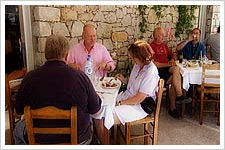 A country drive presents the perfect opportunity to check out little family-run restaurants, like this one in the town of Aliartos. Instead of offering you a menu, it’s common for small restaurateurs to invite you into the kitchen to see what’s on the stove.
A country drive presents the perfect opportunity to check out little family-run restaurants, like this one in the town of Aliartos. Instead of offering you a menu, it’s common for small restaurateurs to invite you into the kitchen to see what’s on the stove.
After polishing off hefty portions of mousaka, we’re detouring to one of Greece’s most hallowed sites.
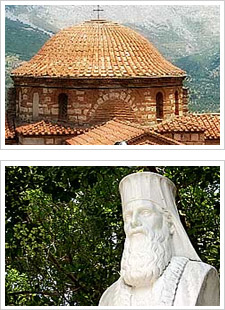 Nestled in an exquisite and remote setting, the Ossios Loukas Monastery was a major architectural of achievement of medieval Greece.
Nestled in an exquisite and remote setting, the Ossios Loukas Monastery was a major architectural of achievement of medieval Greece.
It was named for a local hermit known as Blessed Luke, who showed spiritual leanings even in childhood. Luke left home in his early teens to seek a life of solitude and meditation. He eventually settled on this site and developed a widespread reputation as a healer and prophet. His powers were so legendary that, after his death around 950 AD, this monastery was constructed in his honor.
Countless believers continued to visit here seeking divine intervention and cures. The simple loveliness and serenity of Osios Loukas may set you yearning for a monastic life.
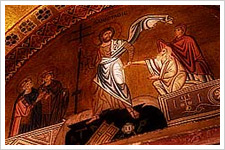 Lined in red and green marble, the church interior is startling in its beauty. Celestial light filters through the windows illuminating the fine Byzantine mosaics. The images illustrate a core drama of the Christian faith: the Crucifixion, Christ descending into hell, and his Resurrection into heaven. Today a handful of orthodox monks still maintain the sacred site.
Lined in red and green marble, the church interior is startling in its beauty. Celestial light filters through the windows illuminating the fine Byzantine mosaics. The images illustrate a core drama of the Christian faith: the Crucifixion, Christ descending into hell, and his Resurrection into heaven. Today a handful of orthodox monks still maintain the sacred site.
TIP
When visiting the Ossios Loukas Monastery, be sure to dress appropriately (no shorts or bare shoulders). For more on visiting the Monastery, visit www.planetware.com.
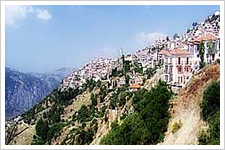 We’re making a quick stop at Arachova, a winsome mountain village on the slopes of Mt. Parnassos. A popular ski resort in the winter, in summer it’s a great place for an afternoon break and a snack on the way to Delphi.
We’re making a quick stop at Arachova, a winsome mountain village on the slopes of Mt. Parnassos. A popular ski resort in the winter, in summer it’s a great place for an afternoon break and a snack on the way to Delphi.
TIP
For more on Arachova, visit www.travel-to-arachova.com.
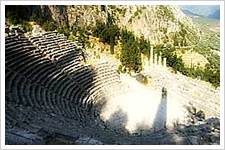 Nearing our destination, we round a rugged mountain slope and Delphi opens before us like a great amphitheatre. Perhaps like no other site, the ancient ruins of Delphi inspire awe, evoking a sort of “spirit of place”. Some consider this the highlight of their trip to Greece - a place of pilgrimage, to visit time and again.
Nearing our destination, we round a rugged mountain slope and Delphi opens before us like a great amphitheatre. Perhaps like no other site, the ancient ruins of Delphi inspire awe, evoking a sort of “spirit of place”. Some consider this the highlight of their trip to Greece - a place of pilgrimage, to visit time and again.
The ancients believed that this was favorite hangout of the great sun god Apollo, and of the Muses - those goddesses who looked after art and music. According to legend, the supreme god Zeus released two eagles at the ends of the earth to fly in opposite directions. They met at Delphi. As a result, the ancient Greeks thought this to be the center of the world.
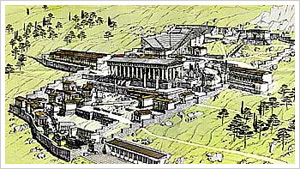
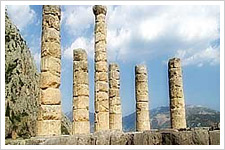 This was the Sacred Way. In ancient times it was lined with statues and treasures given by city-states to thank Apollo for helping them win battles.
This was the Sacred Way. In ancient times it was lined with statues and treasures given by city-states to thank Apollo for helping them win battles.
Apollo delivered prophecies in his temple through a priestess who immersed herself in the smoke of laurel leaves while seated here on the sun god’s throne. She would go into a trance and deliver an unintelligible prophesy that would then be interpreted by priests.
TIP
To find out more on what you'll find at Delphi, go to campus.lakeforest.edu.
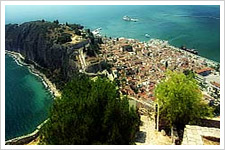 The final leg of our journey takes us to the Peloponnesian Peninsula and the seaside town of Nafplion.
The final leg of our journey takes us to the Peloponnesian Peninsula and the seaside town of Nafplion.
Nafplion beguiles vacationing Athenians, many of whom consider it the prettiest port in the country. It radiates a grand, fading elegance left over from the days when it was the first capital of modern Greece back in the early 19th century.
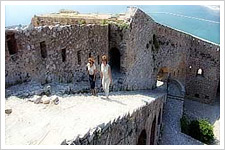 High above town, the Palamidi Fortress offers dazzling views. While the Greeks and Romans exploited the advantages of this lookout for hundreds of years, the Venetians really built-up the fortification in the 18th century, which explains why the Lion of St. Mark, Venice’s symbol, appears above various gates. It was designed to withstand all artillery of the day, though it fell to the Ottomans after a mere one-week attack. The fortress also became an important military site during Greece’s War of Independence, when a Greek commander laid siege here for more than a year before gaining control.
High above town, the Palamidi Fortress offers dazzling views. While the Greeks and Romans exploited the advantages of this lookout for hundreds of years, the Venetians really built-up the fortification in the 18th century, which explains why the Lion of St. Mark, Venice’s symbol, appears above various gates. It was designed to withstand all artillery of the day, though it fell to the Ottomans after a mere one-week attack. The fortress also became an important military site during Greece’s War of Independence, when a Greek commander laid siege here for more than a year before gaining control.
TIP
You'll find more on visiting the fortress at www.planetware.com.
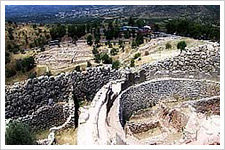 About a half-hour drive from Nafplion are the four thousand year old ruins of ancient Mycenae. This was the heart of the mighty Bronze-age civilization that for a time dominated the Mediterranean. The Mycenaeans left an incomparable legacy to the western world, inspiring the poetry, drama and art of the early Greeks. The tragic dramas of King Agamemnon, Homer’s epic tales, and the mythical labors of Hercules can all be traced to this area.
About a half-hour drive from Nafplion are the four thousand year old ruins of ancient Mycenae. This was the heart of the mighty Bronze-age civilization that for a time dominated the Mediterranean. The Mycenaeans left an incomparable legacy to the western world, inspiring the poetry, drama and art of the early Greeks. The tragic dramas of King Agamemnon, Homer’s epic tales, and the mythical labors of Hercules can all be traced to this area.
TIP
Check out the great new translation of Homer's Odyssey by Robert Fagles. You'll find the review at hallaudiobook.com and www.penguinputnam.com.
For an update on another discovery linking Homer's tales to the Mycenae, go to www.timesonline.co.uk.
For more on the man who uncovered the treasures of Mycenae, Heinrich Schliemann, go to www.unmuseum.org.
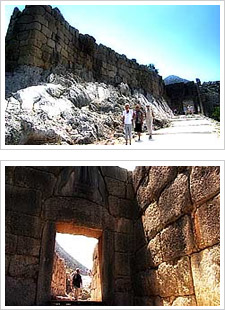 When Agamemnon and his men marched through this Lion Gate off to Trojan War, they left behind a rich and prosperous kingdom.
When Agamemnon and his men marched through this Lion Gate off to Trojan War, they left behind a rich and prosperous kingdom.
Inside the gate is the royal cemetery where the great kings were buried. It was here that the magnificent gold treasures that we saw in the National Archeological Museum were excavated. The main path leads to king’s palace. This is where the royal apartments were and where it’s believed that Agamemnon’s wife and her lover murdered the mighty king. Legend holds that Orestes, Agamemnon’s son, killed his mother to avenge his father’s death, and then escaped through a back gate.
TIP
The ruins of Mycenae are steep and slippery in places; be sure to wear good walking shoes.
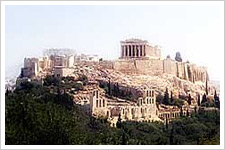 Just mention Greece, and you summon awe-inspiring images and exalted feelings. In the words of an ancient Greek historian, “Mighty indeed are the marks and monuments of our empire which we have left. Future ages will wonder at us, as the present age wonders at us now.”
Just mention Greece, and you summon awe-inspiring images and exalted feelings. In the words of an ancient Greek historian, “Mighty indeed are the marks and monuments of our empire which we have left. Future ages will wonder at us, as the present age wonders at us now.”
Our journey has come to an end – for now. But we’ll continue to wonder at the monuments of this land. And look forward to our next quest for the glory that is Greece.
- Introduction
- Athens
- Acropolis
- Parthenon
- Agora
- Plaka
- Andromeda Apartments
- Aristeria Dexia Restaurant
- Monastiraki Square
- Greek Dance
- National Archeological Museum
- Changing of the Guard
- Out of Athens
- The Restaurant in Aliartos
- Ossios Loukas Monastery
- Arachova
- Delphi
- Nafplion
- Palamidi Fortress
- Mycenae
- Quest for Glory

Interested in planning your vacation to Greece?
Start your trip at
Expedia.com/Greece
Links
To avoid huge crowds and hot mid-day sun, visit the Acropolis early in the morning. For more on the Acropolis and surrounding area, check out the
A Quick Tour of the Acropolis and A Quick Tour of the Agora.
For more on Arachova, visit www.travel-to-arachova.com.
To find out more on what you'll find at Delphi, go to campus.lakeforest.edu.
